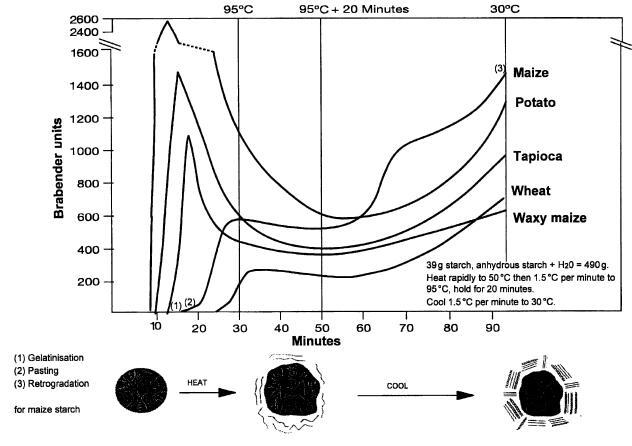Use of Starch in Meat Cure
Introduction
Starch is a well-known ingredient in the food industry for its water-binding capabilities. It has been mass-produced in the United States since the end of World War II and has become very available worldwide as a commodity ingredient. Beyond its famous use in gravy and cherry pie filling, increased use of starch by the U.S. meat industry has been driven by higher levels of poultry usage and a demand for affordable, quality In this chapter, starch sources and modifications are presented as they pertain to providing economical, innovative, and desirable meat products. Guidelines and understanding of starch technology in meat will be given. Practical information is provided to make starch selection easier in regard to formulation in the kitchen, pilot plant, or full-scale manufacturing in combination with other ingredients.
History of the Use of Starch in Meat
Food historians confirm that starches have been used as meat fillers from ancient times forward. Recipes were developed according to custom and cuisine. Examples are ancient Roman Minces, Swedish Meatballs, or American Meatloaves, which all have the same historical culinary background. Earliest starch-filled meat minces were generally made with cooked/preserved starch-containing vegetables. It is also confirmed that prehistoric cooks used starches to thicken soups and stews, by acting as a binding agent. More importantly, it stretched the food in order to feed more people. The high carbohydrate content of most starches satisfies hunger better than liquidthinned recipes. It is also possible that meat minces evolved from quick-cooking techniques widely practiced in the Middle Eastern/Asian region, where cooking fuel was scarce. Stir-fry and kebabs are two examples of this (Olver, 2007).
It took many more centuries, however, for starch to become industrially available for usage in food and meat. As Bergsma (2000) describes, the first “industrial processes” for the manufacture of wheat or potato starches date back to 1772.
Further advances were made in the nineteenth century, but the most significant industrial development occurred between 1940 and 1960 with the finding that a variety of reagents could be reacted with ungelatinized starch granules in water systems to achieve degrees of derivatization sufficient to markedly change the properties of the treated starches.
The type of starches used in meat products varies from region to region. In European meat products where starch is part of the recipe, potato starches are traditionally used, for availability and functionality. As a part of the recipe for meat products and certain dishes, especially in Scandinavia, boiled and coarse-cut or mashed potatoes can be found, which are now commonly replaced by industrial food starches. In other regions such as Asia, the traditionally used native tapioca or wheat starches are being replaced by modified starches of any type.
Starch Structure and Function
Source
Starch is a form of energy reserve for vegetables. It is usually stored in the grain/ seed to be used as an energy source during germination and initial growth of the plant. This family is represented by corn (maize), wheat, rice, oats, etc. It is also present in roots, tubers, and tree trunks (stems) for the same purpose. This starch family is found in potatoes, tapioca (cassava), sago trees, etc. In North America, the most commonly used starch in meat applications is corn-based, while in Europe potato starch is the most predominant. These particular preferences for starch sources are primarily determined by the predominant crop of each continent. As shown in Table 2.1 , each starch source presents unique characteristics important to its selection for use in a meat formulation. Each starch source can be identified microscopically by the shape, diameter range, and coloration of its granules when stained by potassium iodine. The microscope is the tool most commonly used to identify starch (and its cook status) when its source is unknown in a meat product.
Structure
Native Structure
Refined starch is a fine white powder made of starch granules. Each granule is organized in a “ring” pattern of glucose chains: amylose and amylopectin polymers, the two pillars of starch functionality. Refined starch also has residual proteins, lipids, minerals, and moisture at levels that are dependent on the starch source and on the “washing” step during the starch manufacture.
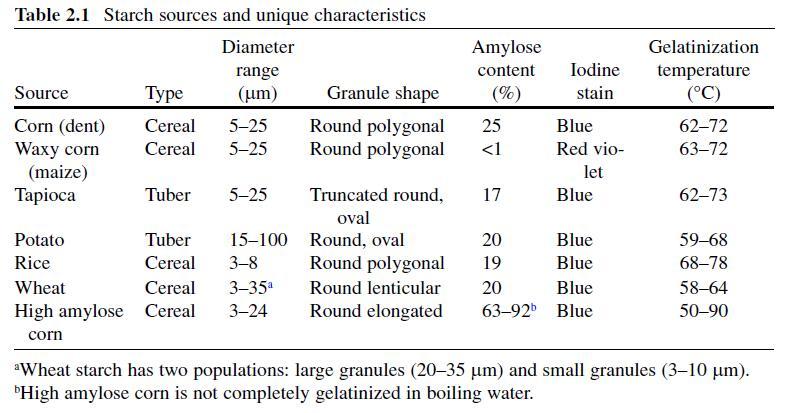
The starch source is the first thing to select when choosing to formulate with a starch. With chemical and/or physical modifications, it is the key to providing the desired attributes to the meat.
As explained before, there are many options, and we will only present the most common here. Table 2.1 describes the characteristics of common starches and their ratio of the glucose polymers amylose and amylopectin found in their native states. In this table, it is assumed that amylose and amylopectin combined make up 100% of the starch. For example, potato starch is made up of 20% amylose and 80% amylopectin, and this ratio will give it unique functional properties when it is applied to a meat product.
Amylose and amylopectin are solely differentiated by their glucose chain linkages and provide different water-binding “types.” As Fig. 2.1 illustrates, amylose is a linear glucose polymer chain with a -(1,4)-glucosidic linkages. Amylopectin is a branched glucose polymer with a -(1,4) and a -(1,6) linkages. These linkages will impart different water-binding characteristics, enabling the structure to stay bound over a long period of time in refrigerated conditions, for example. This structure can undergo different chemical and physical modifications to manage water binding during the manufacturing process and the product’s shelf life.
Modified Structure
Starch modifications are made to improve native starch performance. Native starches have limitation in terms of heat-, shear-, and acid-resistance and in stability in refrigerated or freeze/thaw conditions. Modified starches are less limiting in extreme processes and formulations. Some modifications also allow for the addition of some functional attributes to the starch, such as emulsification properties.
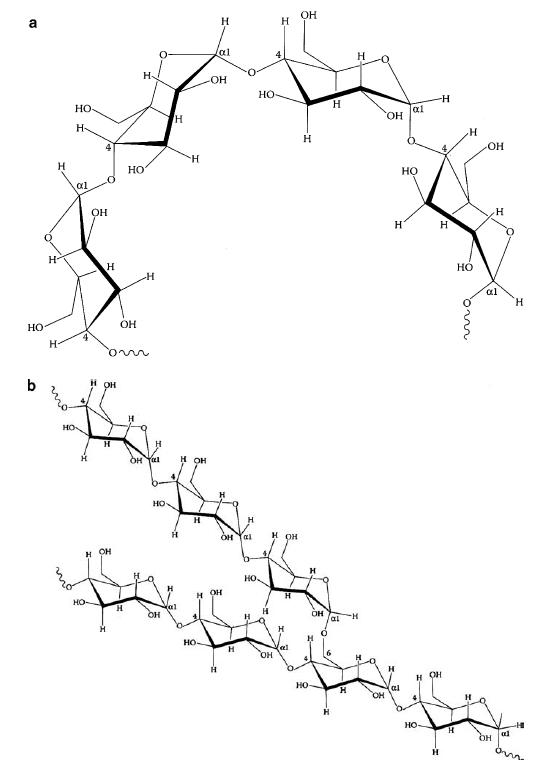
Fig. 2.1 Starch glucose polymer structures (From Mitolo, 2006 . Reproduced with permission)
Regulations. In the United States, the Food and Drug Administration has regulated the starch modifications that are permitted for food use (Code of Federal Regulations [CFR], 2007c) . This regulation also limits the types and quantities of chemicals that can be applied to raw starch during its manufacture, as well as the levels of residual chemicals present in the finished starch. The use of modified food starches must be declared on the ingredient line of meat product labels either by the generic term “modified food starch” or by identifying the starch source, such as, for example, “modified tapioca starch,” “modified potato starch,” or “modified corn starch.”
In Europe, chemically modified starches are classified as food additives. They are assigned E numbers and are regulated in accordance with Directive 95/2/EC on “food additives other than colors and sweeteners,” as amended (European Parliament and Council, 2006) . They have to be manufactured in accordance of specified purity criteria. An overview of the E numbers is given in Table 2.2 .
Chemical Modifications. The array of chemistry available gives meat processors much latitude when choosing a starch that will fit their requirements ( Table 2.3 ).
The modification for better freeze/thaw stability, often required in processed meats, is called stabilization (or substitution) as illustrated in Fig. 2.2 . This modification preserves the starch’s functionality even after freezing. This freeze/thaw stability can be provided to the starch by a propylene oxide reaction. A native starch containing amylose will retrograde over time, upon aging in refrigerated conditions or after freezing/thawing. This is due to the collapse of the amylose chains, which get closer together and release the water in the medium the starch is in. This is called syneresis. It is also referred to in meat products as purge or drip loss. Amylopectin can also retrograde, but at a slower rate and less strongly, thus creating softer “gels.”
Another well-known modification is cross-linking which makes the granule resistant to heat, acid, and shear abuses during the process and preserves its integrity. Cross-linking (Fig. 2.3 ) can be achieved, for instance, by forming a diester with phosphoric acid (POCl 3 is the most common reagent) or by forming an ether bond by reacting with epichlorhydrin . A cross-linked starch may be preferred for retorted meat or meat undergoing several heating processes or a very long cooking procedure.
Some other modifications can be desirable. For instance, the emulsifying properties conferred by an OSA (octenyl succinic anhydride) modification (comprising dual functional hydrophilic and hydrophobic groups) can help in a fatty processed meat to stabilize the fat and keep it in during cooking.
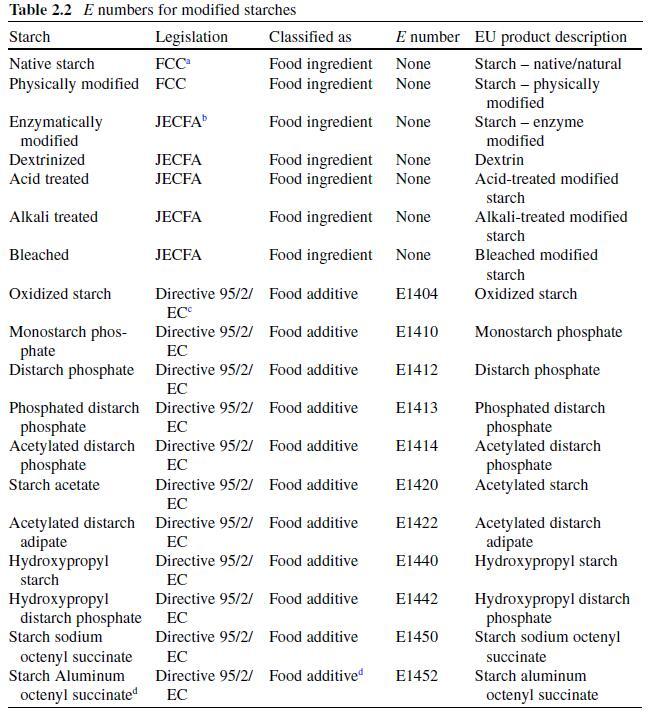
aFCC: Food Chemicals Codex , 5th ed. (Institute of Medicine, 2003).
bJECFA: Compendium of food additive specifications , addendum 9 (Joint FAO/WHO Expert
Committee on Food Additives, 2001).
cDirective 95/2/ec: Directive No. 95/2/ec of 20 February 1995 on food additives other than colours
and sweeteners , amended by directive 2003/114/ec & 2006/52/ec (European Parliament and
Council, 2006) .
dRestricted use.
You may like
Related articles And Qustion
Lastest Price from Starch manufacturers
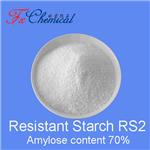
US $0.00-0.00/kg2024-04-11
- CAS:
- 9005-25-8
- Min. Order:
- 1kg
- Purity:
- Amylose 70%
- Supply Ability:
- 20MT

US $0.00/kg2024-03-27
- CAS:
- 9005-25-8
- Min. Order:
- 1kg
- Purity:
- 99%
- Supply Ability:
- 20tons

